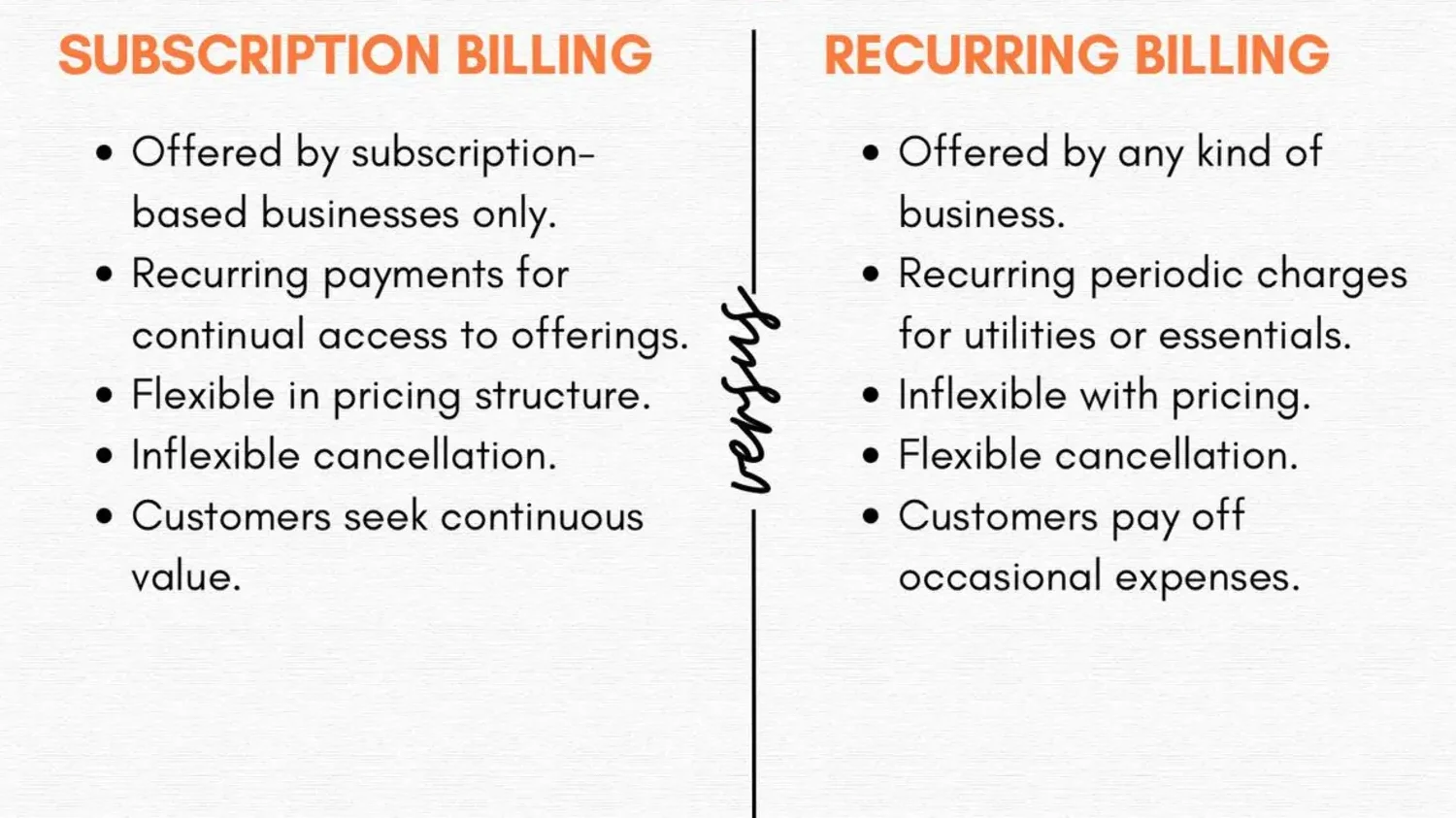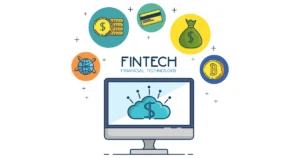In the world of billing and payment processing, two terms that are often used interchangeably are “subscription billing” and “recurring billing”. Despite their apparent similarities, each has remarkable distinctions that significantly affect business operations and revenue generation.
Let us embark on a journey to discover the intricacies that set subscription billing and recurring billing apart. As we journey, you will discover which of them aligns best with your business needs and aspirations.
What is Subscription Billing?
Subscription billing is the automated process of charging subscribers on a regular basis, typically monthly, quarterly, or annually, for a continuous supply of their preferred goods or services over a given time period.
It involves setting up a seamless billing system to ensure that customers are automatically charged at regular intervals to maintain uninterrupted access to their preferred products or services.
Subscription billing is prevalent among businesses that offer subscription-based services, such as streaming platforms, software-as-a-service companies, and membership-based organizations.
Examples of Subscription Billing
Let us delve into 5 common examples of subscription billing to understand how it works in different contexts:
- Software-as-a-Service (SaaS) Subscriptions: Software-as-a-Service (SaaS) companies like Adobe Creative Cloud, Microsoft Office 365, and Salesforce charge customers a recurring monthly or annual fee to access their software tools for video editing, graphic design, and more.
- Streaming Services: Streaming platforms like Netflix, Hulu, and Spotify charge customers a monthly subscription fee to access their extensive library of movies, TV shows, music, and podcasts.
- Meal Delivery Services: Blue Apron, HelloFresh, and Freshly are popular subscription-based meal delivery services that offer weekly or monthly subscription plans to deliver pre-portioned ingredients and recipes to make meal preparation convenient for subscribers.
- Beauty and Wellness Boxes: Birchbox, FabFitFun, and Ipsy are leading the way in subscription-based beauty and wellness boxes. These services curate and deliver a variety of beauty, skincare, and wellness products to subscribers every month, allowing them to explore and experiment with new products.
- Online Fitness Platforms: Peloton Digital, Beachbody On Demand, and Daily Burn are prominent names in subscription-based online fitness platforms. For a monthly or annual subscription fee, subscribers access a diverse range of workout classes, training programs, and fitness content, empowering them to exercise conveniently from the comfort of their homes.
Subscription Billing Models
Businesses adopt a variety of subscription payment models to attract and retain consumers while maintaining a consistent stream of money. Here are some common subscription payment models:
- Fixed Recurring Payments: Here, customers commit to paying a fixed sum of money at set intervals, which could be monthly or annually, in exchange for continued access to a particular product or service. This approach, often observed in memberships at gyms or software subscriptions, ensures a steady fee regardless of how much the customer uses the offering.
- Usage-Based Pricing: In contrast to fixed recurring payments, usage-based pricing adapts charges according to customers’ actual usage of the product or service. For example, Sumo Logic calculates bills based on the amount of data stored or data points processed per minute. This approach provides flexibility and cost-effectiveness, catering to clients with fluctuating usage patterns.
- Tiered Pricing: Customers are presented with a range of subscription tiers, each offering distinct features at varying price levels. This enables customers to choose the tier that best fits their requirements and financial constraints. For instance, Zoho Subscriptions provides standard, professional, premium, and elite tiers, each offering enhanced functionality and support as customers move up the tiers.
- Freemium Model: Here, users are offered a free basic version of a service or product, with the opportunity to enhance their experience by upgrading to a premium paid version for additional features or enhanced functionality. This approach appeals to a broad audience by providing a no-cost entry point, while also generating revenue from users who opt for the upgraded features.
- Bundle Pricing: Here, businesses combine various products or services into a single package, often at a lower price. For example, Zoho Corporation may offer a subscription bundle that includes invoicing, expense tracking, project management, and subscription management software at a discount.
What is Recurring Billing?
Recurring billing is the automated process of billing customers at regular intervals, usually weekly or monthly, for a continual supply of their preferred goods or services.
However, while recurring billing refers to recurring charges for any business, subscription billing specifically refers to recurring charges for subscription-based businesses.
5 Major Differences between Subscription Billing & Recurring Billing

Curious about the differences between subscription billing and recurring billing? Here are 5 of them:
- Scope of Service: Subscription billing is offered by subscription-based businesses such as streaming platforms or software subscriptions, while recurring billing is offered by any kind of business.
- Nature of Payments: Subscription billing involves regular payments for continuous access to a specific product or service, whereas recurring billing encompasses any billing arrangement that includes options for periodic charges and automatic renewal.
- Flexibility: Subscription billing models often offer more flexibility in terms of pricing structures and subscription tiers, allowing businesses to tailor offerings to different customer segments. Recurring billing, however, may have less flexibility, with fixed payment amounts and renewal terms.
- Cancellation Policies: Subscription billing agreements often include termination policies, which could entail minimum subscription durations or early termination charges. In contrast, recurring billing setups may offer more flexibility, allowing customers to opt out at any time.
- Customer Expectations: Customers have varying expectations depending on whether they’re dealing with subscription billing or recurring billing. Subscription billing signifies a continuous commitment to a service, while recurring billing tends to be linked with more occasional or essential expenses like utility bills. Understanding these differences helps businesses tailor their approach to meet customer needs effectively.
Examples of Recurring Billing
Here are 4 examples of recurring billing that are not from subscription-based businesses:
- Mortgage or Rent Payments: Whether you’re a homeowner paying off a mortgage or a tenant renting a property, housing expenses are typically billed on a recurring basis. Payments are often due monthly and can be automatically deducted from your bank account or paid via check to ensure timely payment.
- Utility Bills: Essential utilities like electricity, water, and gas are frequently billed on a recurring basis, usually on a monthly or quarterly schedule. Customers are billed based on their usage during the billing period, with payments conveniently deducted from their bank accounts or charged to their credit cards.
- Insurance Premiums: Insurance policies for auto, home, health, or life coverage often involve recurring billing to maintain continuous protection. Policyholders are billed at regular intervals, such as monthly or annually, and automatic payments are commonly set up to ensure uninterrupted coverage.
- Loan Repayments: Whether it’s a personal loan, car loan, or student loan, borrowed funds typically require recurring billing for repayment. Borrowers make monthly payments over a predetermined period until the loan is fully repaid, often opting for automatic payments to avoid missed payments.
Recurring Billing Models
Let us explore the types of recurring billing models. Whether you are subscribed to a gym membership or are looking to adopt recurring billing in your business, understanding these models can help you navigate recurring payments more effectively.
- Fixed Recurring Billing: In this model, customers are billed a consistent amount at regular intervals, such as monthly or annually, to access a product or service. The recurring fee remains unchanged regardless of usage. This model is frequently seen in services like gym memberships and software subscriptions.
- Variable Recurring Billing: Under this model, customers are charged variable amounts at regular intervals, providing flexibility and cost-effectiveness for those with fluctuating usage patterns. There are two primary types of variable recurring billing:
- Usage-Based Billing: Customers are billed based on the quantity of service or product they consume. The more they utilize, the higher the charges. This model is prevalent among telecommunications and utility companies.
- Quantity-Based Billing: In this scenario, customers are billed according to the quantity agreed upon at the time of purchase. This billing method is commonly found in volume-based cloud storage services.
Which is Appropriate for Your Business: Subscription Billing or Recurring Billing?
When faced with the decision between subscription billing and recurring billing for your business, it’s crucial to carefully evaluate various factors to determine the best fit.
Start by assessing the essence of your business and the products or services you provide. If your business model revolves around granting ongoing access to services with tiered pricing structures and consistent revenue streams, subscription billing may be the optimal choice. It is well-suited for businesses like streaming platforms, software-as-a-service providers, and membership-based organizations.
Conversely, if your business primarily offers products or services with one-time purchase options that can be automatically renewed, recurring billing might be more appropriate. Examples include magazine subscriptions, utility bills, and insurance premiums, where customers are billed regularly for continuous access or usage.
Also, study the preferences and buying habits of your target audience. Are they more inclined towards subscribing to ongoing services or making occasional one-time purchases? Understanding your customers’ preferences is key to determining the most suitable billing model for your business.
Furthermore, consider the scalability and flexibility offered by each billing model. Subscription billing may provide greater flexibility in terms of pricing structures and subscription tiers, enabling you to tailor offerings to diverse customer segments. Conversely, recurring billing may offer simplicity and ease of management for businesses with straightforward billing needs.
Ultimately, the goal is to select a billing model that not only aligns with your business requirements but also delivers a seamless and user-friendly experience for your customers. By meticulously weighing these considerations and exploring the advantages and disadvantages of each option, you can make a well-informed decision that optimizes revenue generation and customer satisfaction for your business.
Frequently Asked Questions About Subscription Billing versus Recurring Billing
What is the difference between a bill and a subscription?
A bill is generally a request for payment for services or products that have been provided, usually as a one-time or infrequent charge. A subscription, in contrast, involves periodic payments that grant continued access to a service or product.
What is a billing cycle?
A billing cycle refers to the period between billing statements, which is often monthly but can vary with different services.
What is the best subscription billing software?
As for the best subscription billing software, it really depends on the specific requirements of a business. Nonetheless, Chargebee, Zuora, and Recurly are frequently recognized for their extensive features and user-friendly interfaces.




